
CCC: Adaptation to climate risks ‘underfunded and ignored’ by UK government
Multiple Authors
06.16.21Multiple Authors
16.06.2021 | 12:01amEfforts to manage climate risks in the UK have been “underfunded and ignored” leaving the nation vulnerable to rising temperatures, according to the Climate Change Committee (CCC).
Global warming is already having far-reaching impacts as heatwaves and floods increase in scale and frequency. These are set to worsen, the CCC says, even if emissions are cut dramatically.
This makes adapting to climate change essential, but, according to the government’s official climate advisers, ministers have failed to grasp the importance of measures such as heat-resilient homes.
Not only could adequate adaptation save lives and money, the committee says, it would ensure a resilient electrical grid and healthy forests capable of sucking up carbon dioxide, both of which are essential to achieve the UK’s legally binding goal of net-zero emissions by 2050.
Due to this, the net-zero goal “will fail” unless the government urgently boosts the nation’s climate resilience, according to the CCC.
In the committee’s new climate “risk assessment”, it outlines a widening gap between the climate risks facing the UK and the government’s plans to shield people from them. It also lays out eight key priority areas to address this “adaptation deficit”.
- ‘Underfunded and ignored’
- The widening gap
- Scenarios and projections
- Costs and benefits
- Tackling the ‘adaptation deficit’
‘Underfunded and ignored’
The new climate change risk assessment is the third to be released as part of the CCC’s obligations under the 2008 Climate Change Act.
It outlines the various risks posed by rising temperatures and what the government needs to prioritise to prevent economic losses, environmental damage and loss of life.
The report considers risks today under 1.2C of observed warming as well as under two main future pathways, which are broadly equivalent to global warming of 2C and 4C above pre-industrial levels. These are based on RCP2.6 and RCP6.0 climate pathways, respectively. (See the “Scenarios and projections” section for more details.)
The main 142-page advice document is accompanied by a “technical report” that runs to nearly 1,500 pages, as well as supporting research and national summaries examining the specific situations in England, Scotland, Wales and Northern Ireland.
This guidance is released every five years and is meant to inform the UK’s government’s own climate risk assessment, which must be presented to parliament in 2022.
Each UK nation must then produce new adaptation plans, setting out how they will respond to the climate risks they identify, “as soon as practicable” from 2023.
(Carbon Brief has previously covered the CCC’s second risk assessment in 2016 and national adaptation programme in 2018. The latter received criticism at the time from the CCC for leaving significant “gaps” in its plans.)
The team behind the new report are frank in their appraisal of the UK government’s progress on adapting to climate risks so far. In a foreword, the CCC’s adaptation committee chair Baroness Brown said that it had been left “under-resourced, underfunded and often ignored”.
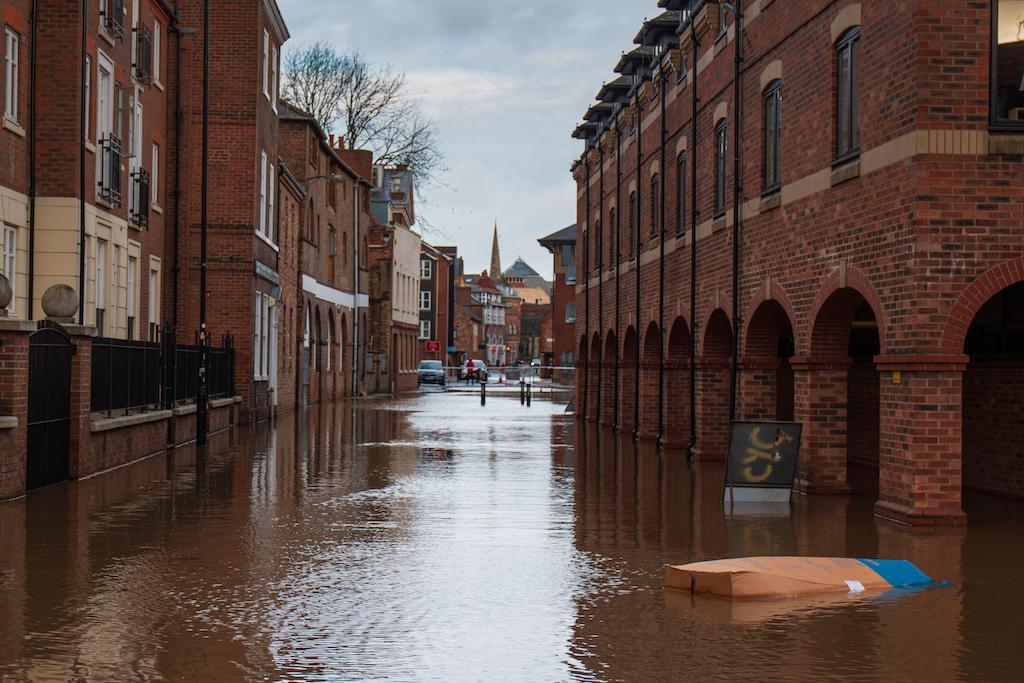
CCC chief executive Chris Stark echoed these points in a press briefing with journalists and said that the government has failed to act sufficiently on previous advice from the committee:
“We have really wanted to get across the extent of the climate risks we face in the UK and the genuinely poor extent of planning that we see for many of them…Our preparations for climate change in this country are not keeping pace with the extent of the risks that we face.”
The report notes that, in recent years, the UK has faced billions in economic losses and thousands of heat-related deaths during events such as the 2018 heatwave. Stark added:
“The oddity for me really is that we are now experiencing climate change quite obviously…and yet the topic of resilience to those changes has a pretty low standing with ministers.”
Rather than rising to meet the challenge, the CCC says that the government has allowed the gap between climate risks and adaptation measures to grow larger.
Irreversible changes and high costs have been “locked in” as programmes, such as house building, have proceeded without accounting for rising temperatures, as Stark noted:
“We are frustrated…some of these issues, like overheating in buildings, we have been raising with [the government] consistently now for over a decade.”
The widening gap
In its report, the committee highlights 61 climate change impacts and identifies 34 as requiring urgent attention. Areas at risk range from food security to cultural heritage.
Besides risks, it also examines areas of opportunity arising from a warmer climate, such as longer growing seasons. However, these are greatly outnumbered by threats.
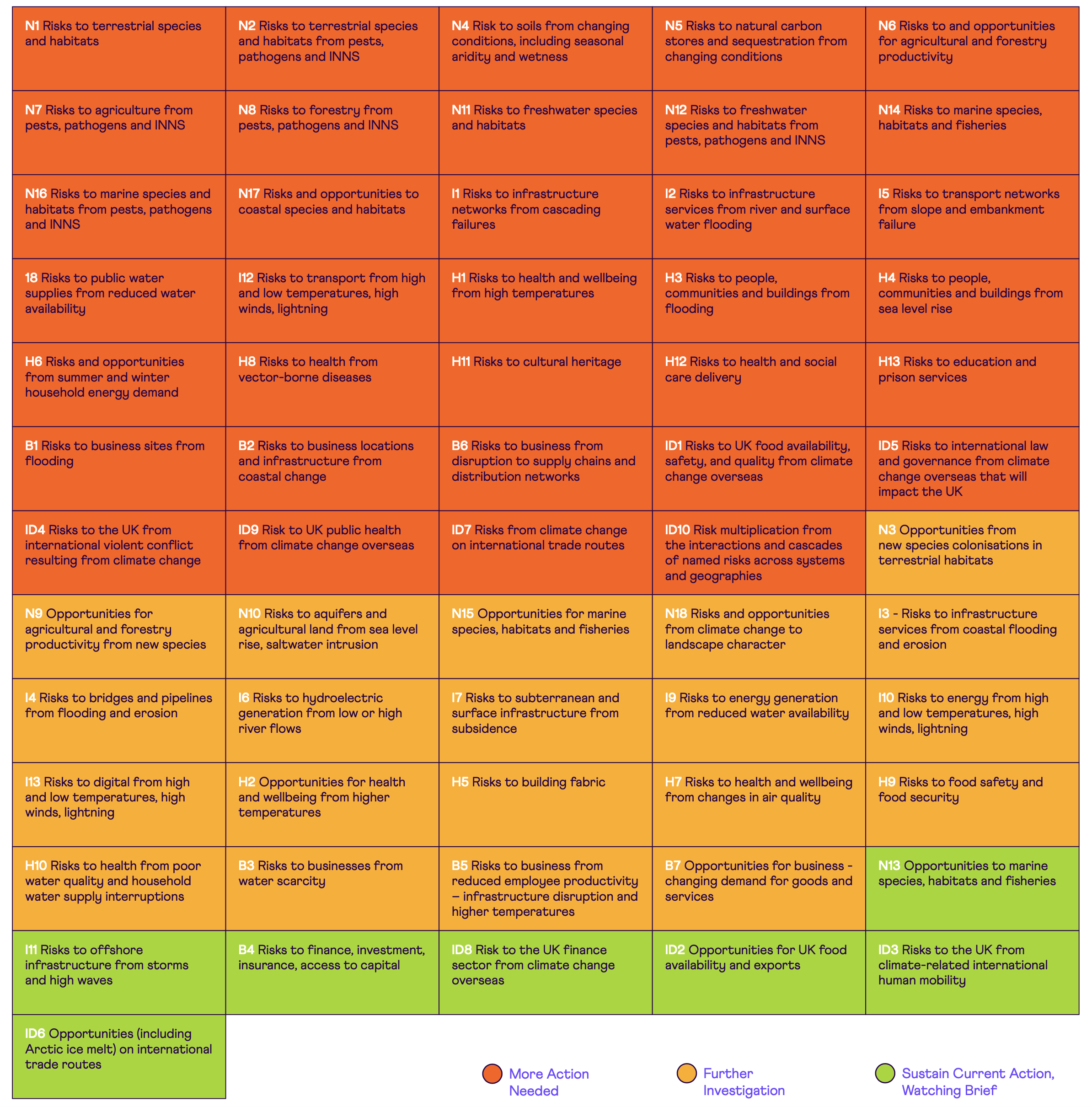
(The CCC’s technical report contains full details of how they identified “risks” and “opportunities”, and assigned them levels of urgency.)
Only four areas are described as being “managed sufficiently” with adaptation plans, including “risks to offshore infrastructure from storms and high waves” and “opportunities from climate change on international trade routes”.
The new risk assessment calls for more urgent action than its predecessor, with an extra 14 areas categorised as “more action needed”, the highest score available. This increase can be seen in the chart below.
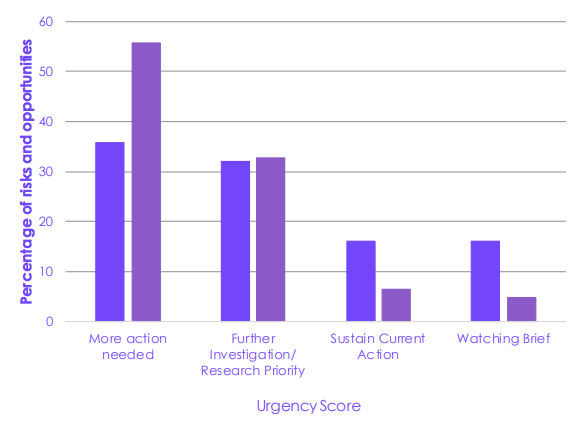
The report notes that “some risks need urgent attention now, even before the next round of national adaptation plans is published from 2023”.
According to Kathryn Brown, head of adaptation at the CCC, some of the differences between the second and third risk assessments are the result of an improved analysis of the climate literature.
Prof Richard Betts is head of climate impacts research at the Met Office Hadley Centre, chair in climate impacts at the University of Exeter and co-author of the technical report. He told a press briefing that, for a given level of global warming, newer projections suggest that some climate hazards in the UK – such as heatwaves and extreme rainfall – are now expected to be more severe than previously thought.
Brown told the same press briefing:
“That’s part of the story, but the other part is…there is good evidence in this assessment that the gap between the level of adaptation and the level of risk in the future has widened as well.”
The committee concluded that the government simply has not given adaptation to climate risks sufficient prominence in its climate change strategies.
According to the report, just four of the 15 major relevant government announcements since 2017 have integrated plans for adaptation alongside cutting emissions.
The UK’s nationally determined contribution, the prime minister’s “10-point plan” and his government’s 25-Year Environment Plan for England all largely overlook it.
Baroness Brown pointed to the “ill-fated” green homes grant as a key example of a policy that failed to integrate adaptation, despite funding for home renovation providing ample opportunities to climate-proof buildings.
Stark identified a “willful reluctance to factor [adaptation] into policymaking”, in part because it “doesn’t have the glamour of net-zero attached to it”.
This is noteworthy, given that the report highlights the impact that climate hazards will have on the UK achieving various societal goals, including the net-zero target itself.
Rising temperatures could lead to trees dying off, peatlands drying out and natural disasters threatening clean infrastructure, all of which could hamper efforts to decarbonise the economy. Stark concluded:
“We will fail on net-zero and we will fail to improve the environment overall if we don’t factor in the changes in the climate that are coming by 2050.”
Scenarios and projections
Underpinning the risks and adaptation needs outlined in the report is the data showing how the climate of the UK – and the world as a whole – is changing.
Since the second risk assessment, the world has “continued to warm with effects on UK and global weather”, the CCC says, adding that it is “beyond doubt” that climate change is a result of human activity.
The warming climate is “bringing unfamiliar local weather patterns, making some types of extreme weather events more likely and causing an accelerated rise in sea levels”, the CCC says. These changes “are altering the stability of ecosystems and habitats, and increasing weather-related risks to people, both around the world and in the UK”.
Temperature and sea level rise – shown in the charts below – are the “clearest signals of a changing climate for the UK”, the report says, noting that the UK’s annual average temperature has warmed by nearly 0.3C per decade since the 1980s. It adds:
“UK sea levels have risen by 16cm since 1900. Episodes of extreme heat are becoming more frequent, with the chance of a hot summer like 2018 now up to 25% per year compared to less than 10% a few decades ago.”
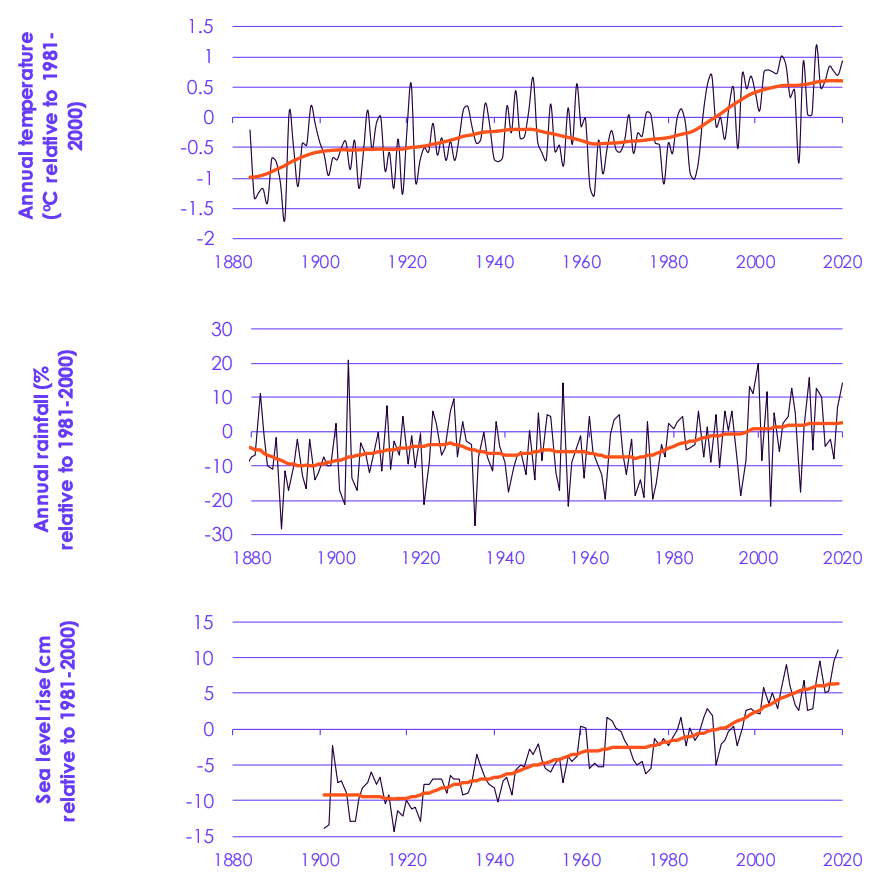
Looking ahead, the risk assessment draws “extensively” on the latest set of climate change projections for the UK, called the UK Climate Projections 2018 – or “UKCP18” – and produced by the Met Office Hadley Centre. (For more on UKCP18, see Carbon Brief’s in-depth Q&A.)
UKCP18 uses emissions scenarios linked to the Representative Concentration Pathways (RCPs) – a set of trajectories of future concentrations of greenhouse gases and other climate “forcings” that were developed initially for the fifth assessment report of the Intergovernmental Panel on Climate Change (IPCC).
The approach for CCRA3 uses two main pathways of future warming, with the addition of a third that provides “wider context for the risk assessment”.
The chart below, from the CCRA3 technical report, shows the projections for the two principal pathways. The blue pathway describes “an approximate minimum level of global warming that can be expected if humans take action to reduce their influence on climate”, and sees global warming “limited to approximately 1.5-2.5C” above pre-industrial levels by 2080-2100.
This 1-5-2C range “encompasses a large proportion” of the UKCP18 projections that use the RCP2.6 emissions scenario, the report notes.
The orange pathway describes an “approximate maximum rate of global warming consistent with a continuation of current human influence” and sees around 4C of warming by 2080-2100. This pathway “quantifies the risks that we wish to avoid or reduce through mitigation, or for which adaptation may be needed if no mitigation action occurs”, the report says.
The CCRA3 higher warming pathway is defined as “the range between the 50th and 95th percentiles in the UKCP18 projections driven by RCP6.0 emissions”, the report notes. It adds that there is also some overlap with the upper end of projections using the RCP4.5 scenario and the lower end of RCP8.5.
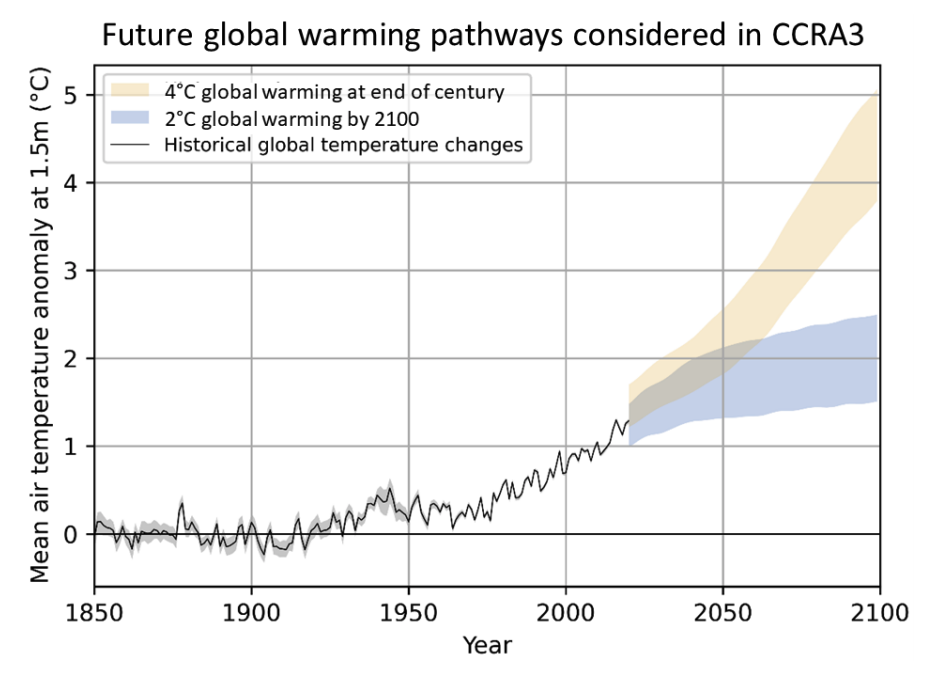
The third pathway “recognises the possibility of even higher rates of warming”, the report explains. This forms part of a wider approach of considering “low-likelihood, high-impact” events, such as tipping points or strong feedbacks involving the carbon cycle, that “may themselves lead to faster rates of warming or sea level rise”. These are informed by “higher warming RCP8.5” projections, the report explains.
This pathway is “not used directly for assessing the magnitude of risks or for scoring the urgency of adaptation”, the report says, but is “presented as wider context” so that high warming rates “can be considered if any adaptation decisions are very sensitive to low-likelihood, high-impact outcomes”.
The CCC warns that the UK will see “ongoing increases in temperature until the middle of the 21st century under all scenarios for future global climate change”, with a range of impacts:
“The UK is more likely to experience warmer and wetter winters in future together with hotter and drier summers. Rainfall and temperature extremes will become more intense and frequent. Sea levels will continue to rise around the UK.”
From the 2050s onwards, a “wide range of future UK climates remains possible”, it says:
“If the world successfully reduces emissions to limit global warming to the temperature goal of the Paris Agreement, only limited changes would occur in many aspects of UK climate beyond those expected by 2050 (however, sea levels would continue to rise). If global emissions remain high, summers will continue to become even hotter and drier, and winters warmer and wetter.”
The table below, from the advice report, summarises some of the observed and projected changes.
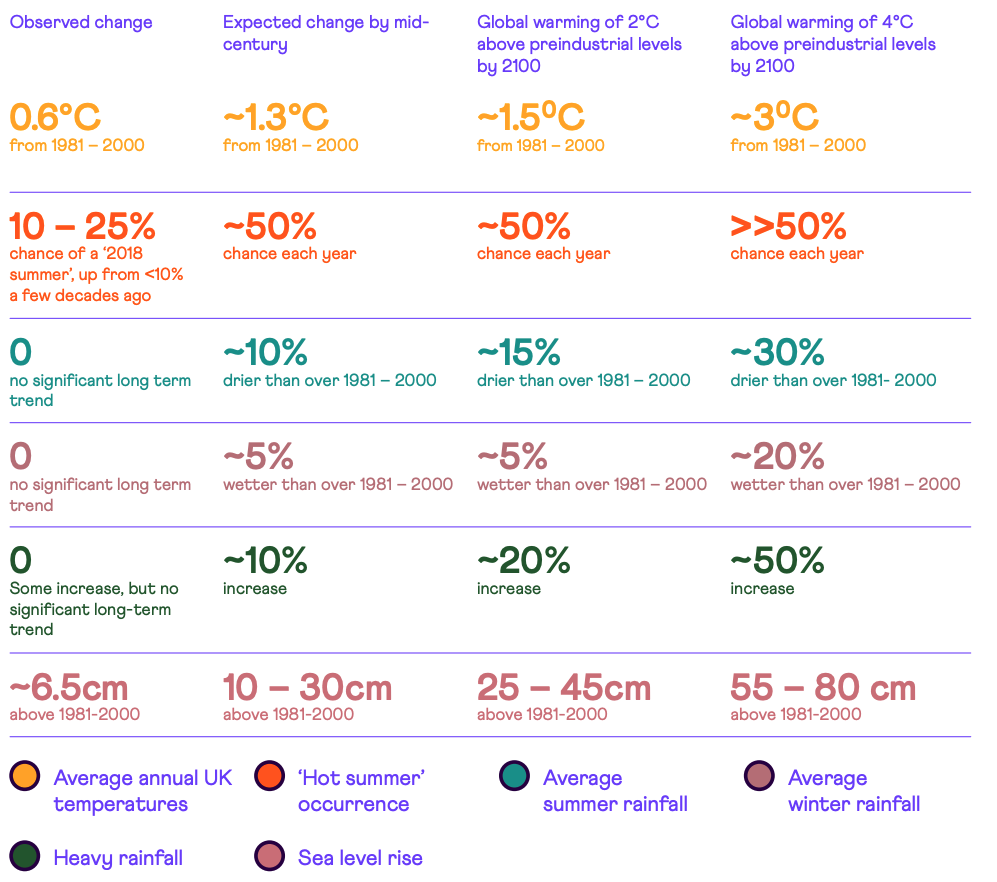
The CCRA3 uses these projections to assess and score the risks and opportunities to the UK from climate change. In total, 61 risks and opportunities have been assessed relating to the “natural environment, infrastructure, health and built environment, business, and international dimensions”. The assessment, which also draws on several “calls for evidence”, covers three questions:
- What is the current and future level of risk or opportunity?
- Is the risk or opportunity being managed, taking account of government action and other adaptation?
- Are there benefits of further action in the next five years, over and above what is already planned?
Using the answers to these three questions, each risk and opportunity has been awarded an “urgency score” using one of four categories: “more action needed”; “further investigation”; “sustain current action”; and “watching brief”.
The figure below shows how the magnitude of these risks (orange and red bars) and opportunities (green bars) are expected to change with time and the different warming pathways.
The CCC finds that the percentage of “high” magnitude risks (red bars) increases from 26% of the total in the present day (14 risks), to 79% in the 4C scenario in the 2080s (42 risks). It adds that “even in the 2C pathway there is still a significant proportion of high magnitude risks by the 2080s (64%, or 34 risks)”.
The CCC notes that “this semi-quantitative scoring needs to be improved in future assessments”.
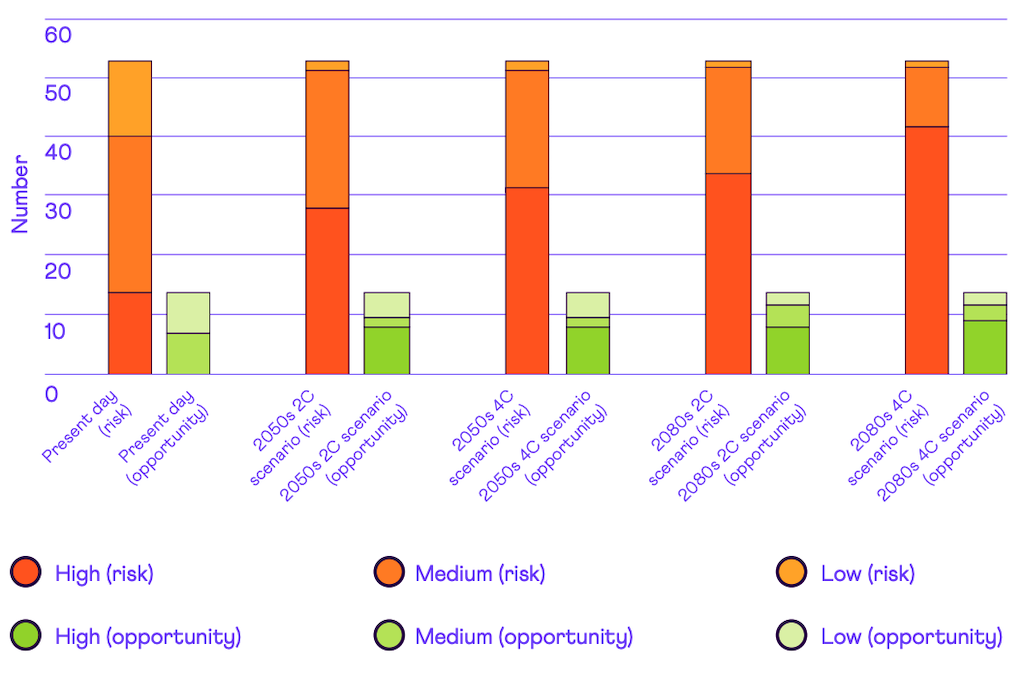
The CCRA3 also includes an assessment of “threshold effects”, which describe points at which “non-linear” changes occur in a system as a result of change in a climate driver. One example is that “algal blooms in rivers start to occur above temperatures of 17C”, the report says.
Understanding where these thresholds exist and how likely they may be in the future is important, the CCC notes, but they are “usually ignored by risk assessments that rely on linear models of change”.
The CCC has considered “key threshold points” between the present day and 2100 for each risk and opportunity in its assessment. These mainly include “biophysical” thresholds – shown in the figure below – but also those relating to engineering or design – such as critical national infrastructure being typically designed to withstand a one-in-200-year flood – and social thresholds beyond which a human-derived unacceptable limit is reached.
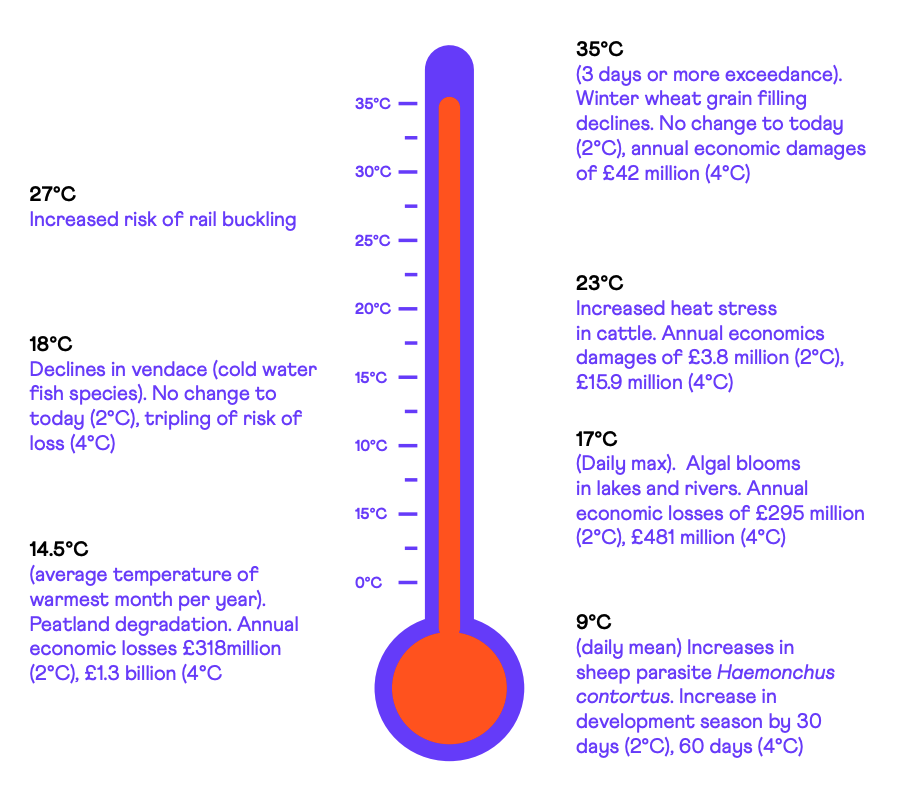
Costs and benefits
The CCC says that calculating the costs and benefits of climate risks is difficult, but its overarching conclusion is that “acting now will be cheaper than waiting to deal with the consequences”.
A “valuation report” to examine economic costs was prepared to accompany the technical report and this influenced the assessment of each risk and opportunity. (This report was not available to journalists before the assessment’s launch.)
While it is relatively straightforward to calculate the value of mitigation based on tonnes of greenhouse gases reduced, evaluating the financial impact of climate hazards is much harder.
The technical report explains that the CCC drew from a diverse range of studies to assess costs. However, gaps in the literature – particularly regarding the natural environment – and inconsistencies in methodologies made it difficult to assess them as a whole.
As a result, it was not possible to provide a figure for the total cost of all risks and opportunities, expressed as a % of GDP, as the CCC has for previous assessments of mitigation efforts.
Nevertheless, the valuation report’s estimates for specific hazards suggest costs could reach tens of billions per year by the 2080s.
In the press briefing, the report’s authors emphasised that the analysis they were able to perform indicated significant benefits arising from adaptation.
As the chart below shows, some adaptation actions – such as water efficiency measures and heatwave planning – have benefits that are more than 10 times greater than costs. Adaptation would also likely bring significant additional benefits for health, wellbeing and nature, the CCC says.
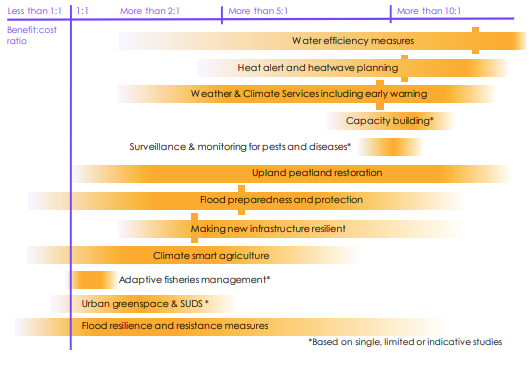
Asked about the UK Treasury’s long-anticipated evaluation of the cost of net-zero, Stark told journalists: “They are not looking at adaptation, and they should be”.
He said that, in the coming years, he expects the CCC to spend much more time looking at how the Treasury is valuing climate risks and what provisions it is putting in place for them.
Given the current lack of funding mechanisms for adaptation, the report advises that the next iteration of national adaptation plans must set out clear means by which to support these measures. One example it gives is extending mechanisms that currently cover low-carbon buildings to include resilience as well.
More broadly, the report also identifies “10 principles for good adaptation planning” to feed into government plans and says that addressing the unequal impacts of climate change should be part of the government’s “levelling up agenda”.
Tackling the ‘adaptation deficit’
Given the numerous challenges set out in the report, the CCC attempts to whittle them down to a manageable level, picking eight top priority risks from the list of 34 high priority items.
Each requires attention “at the highest levels of government over the next two years”, the CCC states. These areas are laid out in the chart below, with an associated risk score indicated by the yellow and orange lines.

The core and technical reports include extensive detail on each of these areas and what the government can do for each one to adapt to climate change. They are summarised below, with a selection of the measures proposed by the CCC.
Overheating homes and buildings
Since the last assessment, the CCC says more than 570,000 new, non-heat resilient homes have been built and since 2018 more than 4,000 heat-related deaths have been recorded in England.
The importance of making buildings more suitable for higher temperatures has been a consistent message from the committee since its first risk assessment, yet it notes that “this risk is notable for being the one where policies still remain largely absent”.
In addition, more people in the UK are now working from home due to Covid-19 and the CCC notes that exposure to heat in homes could, therefore, increase, if this trend continues.
Among the many measures proposed by the CCC are:
- Updating building regulations to address overheating in new and refurbished homes using passive cooling measures, such as “reflective surfaces and green cover”.
- Guidance and incentives to address overheating in existing homes.
- Coordinating decarbonisation and adaptation policies for homes, to deal with potential trade-offs between energy efficiency gains and overheating risk.
Climate change impacts overseas
Many climate impacts are more severe in other parts of the world and the report highlights the threat of “cascading risks that spread across sectors and countries, creating impacts an order of magnitude higher than impacts that occur within a single sector”.
Potential factors examined in the technical report include disruption to food supplies, climate-induced migration and risks to the UK from international violent conflict resulting from climate change overseas.
The CCC says there is an opportunity to learn from the Covid-19 pandemic and improve resilience with a range of measures:
- The Foreign Office should “work to reduce underlying vulnerabilities and not just respond to disasters” in its overseas programmes. (This comes after the government cut its foreign aid budget from 0.7% to 0.5% of total national income.)
- COP26 should feature the UK government committing to more adaptation financing and capacity building to help developing nations implement adaptation actions. (Currently, just one-fifth of international climate finance goes to adaptation.)
- The Cabinet Office should develop a UK Resilience Strategy.
Power system
The UK’s dependence on electricity is expected to rise significantly if it achieves net-zero emissions, with up to 65% of its energy coming from the power sector by 2050 compared to around 20% today.
This would leave the nation far more vulnerable to the impact of power outages, which could be triggered by various climate-related incidents, such as storms and flooding. According to the CCC:
- The government should work with the energy regulator Ofgem and industry to review the overall approach to electricity system design and risk assessment.
- The energy white paper and the new national infrastructure strategy provide opportunities to embed climate resilience in the power system.

Carbon stores and sequestration
Hotter and drier conditions could threaten the peatlands and forests that would otherwise remove significant volumes of carbon dioxide (CO2) from the atmosphere.
Ensuring these carbon stores remain functional is essential for net-zero. The CCC notes that it expects “nature-based solutions” to remove 50m tonnes of CO2 (MtCO2) per year by 2050, adding that “even a small loss from existing stores could entirely offset this”.
To ensure this does not happen, the CCC proposes:
- Targeted actions to restore degraded carbon stores, particularly peatlands. (Some measures were recently laid out in the government’s peat strategy for England.)
- Better spatial targeting for land-use change initiatives to avoid harming carbon stores.
- More research to account for climate risks to carbon stores in the UK’s greenhouse gas inventory projections.
Food, goods and supply chains
Domestic and international supply chains for everything from food to cars are at risk from climate change due to pressures such as drought, flooding and heatwaves.
The CCC says improving supply chain resilience should be prioritised for post-Covid planning and in the development of new trade agreements following Brexit:
- Opportunities to integrate adaptation into forthcoming policies include the Treasury’s plan for growth, the green finance strategy and the development of a global reporting system led by major sustainability reporting organisations.
- Plans for the UK to grow some currently imported fruit and vegetables domestically if possible.
Agriculture
Despite the direct risks posed to crops, livestock and commercial trees by climate hazards, the CCC says there is “no clear evidence that climate risks or opportunities for agriculture and forestry are being strategically managed across the UK”.
While the committee says forthcoming policies for land management, net-zero and nature protection provide opportunities to embed climate resilience, they are “not being taken”.
According to the CCC, an effective adaptation response will require:
- Different or new varieties of crops, livestock and trees that are more climate resilient.
- Changes to land management, including better technologies for managing water and nutrient input and improved soil conservation.
- Better long-term seasonal forecasts for land managers, assessment of land-use options given changing water availability and land-use strategies that bring climate change mitigation and adaptation together.
Terrestrial and freshwater habitats
Climate change is one of many factors leading to a general decline in UK biodiversity.
While the government has stated that reversing this decline is one of its core priorities, through strategies such as the 25 Year Environment Plan, the CCC says there is “a lack of evidence” to show such plans are being implemented.
The UK is currently reviewing its environment policy following Brexit and the committee says this provides a “once-in-a-generation opportunity” to ensure adaptation is accounted for. It proposes:
- Including adaptation in conservation planning, ensuring that sites are prepared for current and future climate hazards.
- Better monitoring of pests, diseases and invasive non-native species.
- Using nature-based solutions to reduce human exposure to flooding and extreme heat.
Soil health
The UK’s environmental targets require better soil health in the future, including a 10% per decade improvement in crop yields in the CCC’s net-zero projections.
This could be hampered by climate change, with heavier rainfall leading to erosion and hot summers drying out the soil. The committee’s technical report highlights areas for improvement including:
- Investment in national-scale soil monitoring programmes.
- Incentives for land managers to improve soil health.
- Improved uptake of precision farming technology to minimise soil erosion and pollution.
-
CCC: Adaptation to climate risks ‘underfunded and ignored’ by UK government
-
CCC: ‘Poor planning’ has left the UK unprepared for climate change

